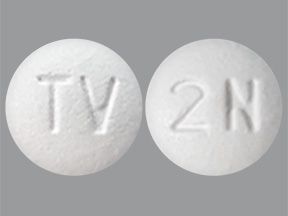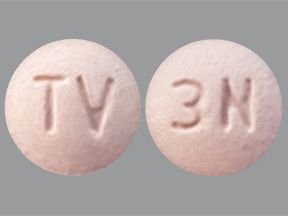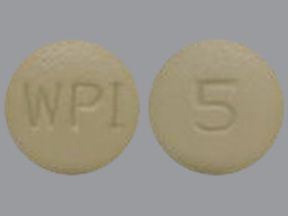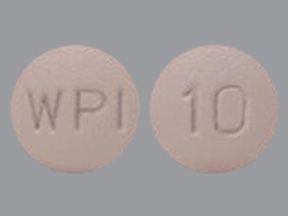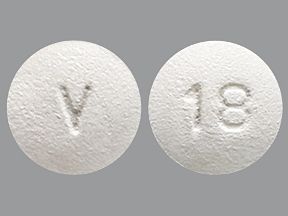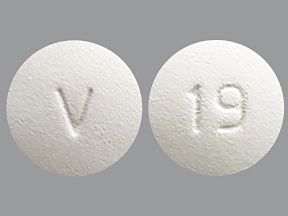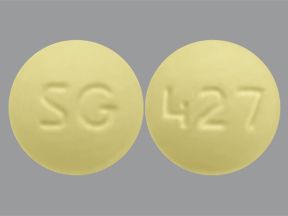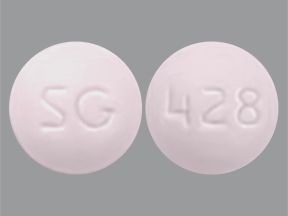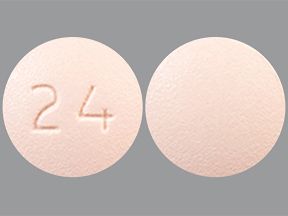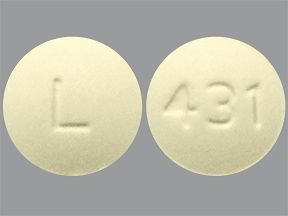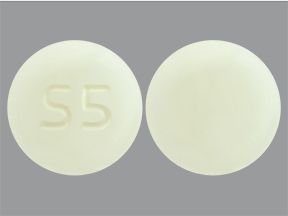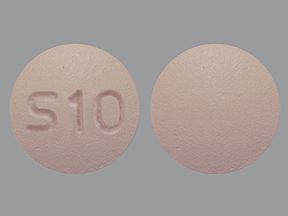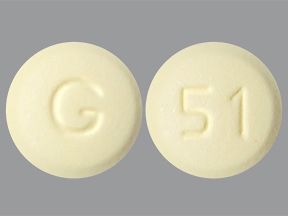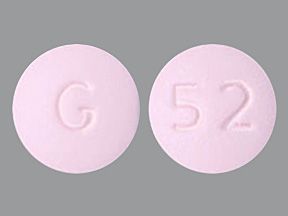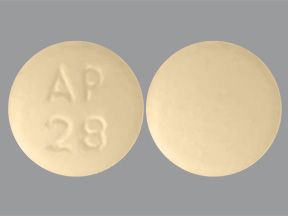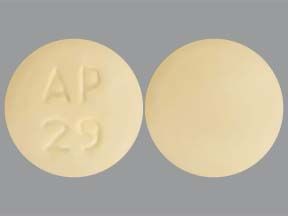Highlights for solifenacin
- Solifenacin oral tablet is available as a brand-name drug. It’s not available as a generic drug. Brand name: VESIcare.
- Solifenacin comes only as a tablet you take by mouth.
- Solifenacin is used to treat symptoms of overactive bladder (OAB). These symptoms can include a strong need to urinate with leaking or wetting accidents, a strong need to urinate right away, and urinating often.
- Other conditions warning: You shouldn’t take this drug if you have urinary retention, gastric retention, or uncontrolled narrow-angle glaucoma. Use this drug with caution if you have the heart problem called QT prolongation (irregular heart rate).
- Swelling (angioedema) warning: In rare cases, this drug may cause swelling of your face, lips, tongue, or throat. If swelling occurs and makes it hard for you to breathe, call 911 or go to the emergency room right away.
- Dementia warning:
Research has indicated that this type of medication can cause effects similar to those caused by drugs called anticholinergics. This can raise your risk of dementia.
Solifenacin is a prescription drug. It comes only as an oral tablet.
Solifenacin oral tablet is available only as the brand-name drug VESIcare. It’s not available as a generic drug.
Why it’s used
Solifenacin is used to treat symptoms of overactive bladder (OAB). These symptoms include:
- a strong need to urinate with leaking or wetting accidents
- a strong need to urinate right away
- urinating more often than usual
How it works
Solifenacin belongs to a class of drugs called urinary antagonists. A class of drugs is a group of medications that work in a similar way. These drugs are often used to treat similar conditions.
Normally, when your bladder fills with urine, it expands. Once it’s fully expanded, it sends a message to your brain telling it you’re ready to urinate. When you urinate, the muscles in your bladder contract, which starts a flow of urine.
When you have OAB, your muscles contract before your bladder fully expands, which causes frequent urges to urinate. Solifenacin works by stopping sudden bladder muscle contractions and increasing the amount of urine that your bladder can hold. This helps to control the release of urine and helps reduce your symptoms.
Solifenacin oral tablet can affect your central nervous system. This could lead to side effects such as headache, confusion, hallucinations, and drowsiness when starting or increasing your dose of this drug. You shouldn’t use heavy machinery or drive until you know how this medication will affect you.
Solifenacin can also cause other side effects.
More common side effects
The more common side effects that can occur with solifenacin include:
- dry mouth
- constipation
- urinary tract infection
- blurred vision
If these effects are mild, they may go away within a few days or a couple of weeks. If they’re more severe or don’t go away, talk to your doctor or pharmacist.
Serious side effects
Call your doctor right away if you have serious side effects. Call 911 if your symptoms feel life-threatening or if you think you’re having a medical emergency. Serious side effects and their symptoms can include the following:
- Heat exhaustion or heat stroke. This is more likely to occur if you live in a hot environment. Symptoms can include:
- decreased sweating
- dizziness
- tiredness
- nausea
- increase in body temperature (fever)
- Shortness of breath or chest pain
- Swelling of your face, lips, tongue, or throat that makes it hard for you to breathe
- Severe itching
- Hives, skin rash, or swelling
Disclaimer: Our goal is to provide you with the most relevant and current information. However, because drugs affect each person differently, we cannot guarantee that this information includes all possible side effects. This information is not a substitute for medical advice. Always discuss possible side effects with a healthcare provider who knows your medical history.
Solifenacin oral tablet can interact with other medications, vitamins, or herbs you may be taking. An interaction is when a substance changes the way a drug works. This can be harmful or prevent the drug from working well.
To help avoid interactions, your doctor should manage all of your medications carefully. Be sure to tell your doctor about all medications, vitamins, or herbs you’re taking. To find out how this drug might interact with something else you’re taking, talk to your doctor or pharmacist.
Examples of drugs that can cause interactions with solifenacin are listed below.
Antifungal drug
Taking ketoconazole with solifenacin can increase the amount of solifenacin in your body. This may lead to more side effects. Your dosage of solifenacin shouldn’t be higher than 5 mg per day if you’re also taking ketoconazole.
Disclaimer: Our goal is to provide you with the most relevant and current information. However, because drugs interact differently in each person, we cannot guarantee that this information includes all possible interactions. This information is not a substitute for medical advice. Always speak with your healthcare provider about possible interactions with all prescription drugs, vitamins, herbs and supplements, and over-the-counter drugs that you are taking.
This drug comes with several warnings.
Allergy warning
This drug can cause a severe allergic reaction. Symptoms can include:
- trouble breathing
- swelling of your face, lips, throat, or tongue
- hives
Call 911 or go to the nearest emergency room if you develop these symptoms.
Don’t take this drug again if you’ve ever had an allergic reaction to it. Taking it again could be fatal (cause death).
Alcohol interaction warning
The use of drinks that contain alcohol can make your bladder symptoms worse. If you drink alcohol, talk to your doctor.
Warnings for people with certain health conditions
For people with bladder problems: You shouldn’t use this drug if you have urinary retention. Use this drug with caution if you have other problems emptying your bladder. This may increase your risk of urinary retention.
For people with stomach problems: You shouldn’t use this drug if you have gastric retention. Use this drug with caution if you have delayed or slow emptying of your stomach. This may increase your risk of gastric retention.
For people with narrow-angle glaucoma: Use this drug with caution if you have an eye disorder called narrow-angle glaucoma. If you have uncontrolled narrow-angle glaucoma, you shouldn’t use this drug at all.
For people with liver issues: This drug is processed by your liver. If you have liver problems, more of the drug may stay in your body longer, putting you at risk for side effects. Use this medication with caution. Your doctor may lower your dose and may check your liver function during treatment.
For people with kidney issues: This drug is processed by your kidneys. If you have kidney problems, more of the drug may stay in your body longer, putting you at risk for side effects. Use this medication with caution. Your doctor may lower your dose and may check your kidney function during treatment.
For people with an irregular heart rate: Use this drug with caution if you have QT prolongation (irregular heart rate).
Warnings for other groups
For pregnant women: This drug is a category C pregnancy drug. That means two things:
- Research in animals has shown adverse effects to the fetus when the mother takes the drug.
- There haven’t been enough studies done in humans to be certain how the drug might affect the fetus.
Tell your doctor if you’re pregnant or plan to become pregnant. This drug should be used during pregnancy only if the potential benefit justifies the potential risk to the pregnancy.
For women who are breastfeeding: It isn’t known if this drug passes into breast milk. If it does, it may cause side effects in a child who is breastfed. Talk to your doctor if you breastfeed your child. You may need to decide whether to stop breastfeeding or stop taking this medication.
For children: The safety and effectiveness of this drug in children younger than 18 years of age hasn’t been established.
All possible dosages and forms may not be included here. Your dose, form, and how often you take it will depend on:
- your age
- the condition being treated
- the severity of your condition
- other medical conditions you have
- how you react to the first dose
Drug forms and strengths
Brand: VESIcare
- Form: oral tablet
- Strengths: 5 mg and 10 mg
Dosage for overactive bladder (OAB)
Adult dosage (ages 18 years and older)
- Typical dosage: 5 mg taken once per day.
- Dosage increases: If needed, your doctor may increase your dosage to 10 mg taken once per day.
Child dosage (ages 0–17 years)
This medication hasn’t been studied in children. It shouldn’t be used in children younger than 18 years.
Special dosage considerations
- For people with kidney problems: If you have severe kidney disease, your dosage shouldn’t be higher than 5 mg per day.
- For people with liver problems: If you have moderate liver disease, your dosage shouldn’t be higher than 5 mg per day. If you have severe liver disease, you shouldn’t use this drug.
Disclaimer: Our goal is to provide you with the most relevant and current information. However, because drugs affect each person differently, we cannot guarantee that this list includes all possible dosages. This information is not a substitute for medical advice. Always talk to your doctor or pharmacist about dosages that are right for you.
Solifenacin is used for long-term treatment. It comes with serious risks if you don’t take it as prescribed.
If you stop taking the drug or don’t take it at all: Your OAB symptoms will likely not improve.
If you miss doses or don’t take the drug on schedule: Your medication may not work as well or may stop working completely. For this drug to work well, a certain amount needs to be in your body at all times.
If you take too much: You could have dangerous levels of the drug in your body. You may have the following symptoms:
- blurred vision
- dilated pupils
- tremors
- loss of consciousness
If you think you’ve taken too much of this drug, call your doctor or seek guidance from the American Association of Poison Control Centers at 1-800-222-1222 or through their online tool. But if your symptoms are severe, call 911 or go to the nearest emergency room right away.
What to do if you miss a dose: If you miss a dose of this drug, skip that dose and take your next dose as scheduled the next day. Don’t take two doses of this drug on the same day. This could cause dangerous side effects.
How to tell this drug is working: Your symptoms of OAB should improve. You may no longer have a strong need to urinate or a need to urinate often.
Keep these considerations in mind if your doctor prescribes solifenacin for you.
General
- Don’t crush, break, or chew the tablets.
Storage
- Store solifenacin at room temperature. Keep it at 77°F (25°C). It may be stored briefly at a temperature between 59°F and 86°F (15°C and 30°C).
- Keep this drug away from high temperature.
- Don’t store this medication in moist or damp areas, such as bathrooms.
Refills
A prescription for this medication is refillable. You should not need a new prescription for this medication to be refilled. Your doctor will write the number of refills authorized on your prescription.
Travel
When traveling with your medication:
- Always carry your medication with you. When flying, never put it into a checked bag. Keep it in your carry-on bag.
- Don’t worry about airport X-ray machines. They can’t hurt your medication.
- You may need to show airport staff the pharmacy label for your medication. Always carry the original prescription-labeled container with you.
- Don’t put this medication in your car’s glove compartment or leave it in the car. Be sure to avoid doing this when the weather is very hot or very cold.
Clinical monitoring
Before starting and during treatment with this medication, your doctor may check your:
- liver function
- kidney function
Prior authorization
Many insurance companies require a prior authorization for this drug. This means your doctor will need to get approval from your insurance company before your insurance company will pay for the prescription.
Availability
Not every pharmacy stocks this drug. When filling your prescription, be sure to call ahead to make sure your pharmacy carries it.
There are other drugs available to treat your condition. Some may be better suited for you than others. Talk to your doctor about other drug options that may work for you.
Disclaimer: Healthline has made every effort to make certain that all information is factually correct, comprehensive, and up-to-date. However, this article should not be used as a substitute for the knowledge and expertise of a licensed healthcare professional. You should always consult your doctor or other healthcare professional before taking any medication. The drug information contained herein is subject to change and is not intended to cover all possible uses, directions, precautions, warnings, drug interactions, allergic reactions, or adverse effects. The absence of warnings or other information for a given drug does not indicate that the drug or drug combination is safe, effective, or appropriate for all patients or all specific uses.

